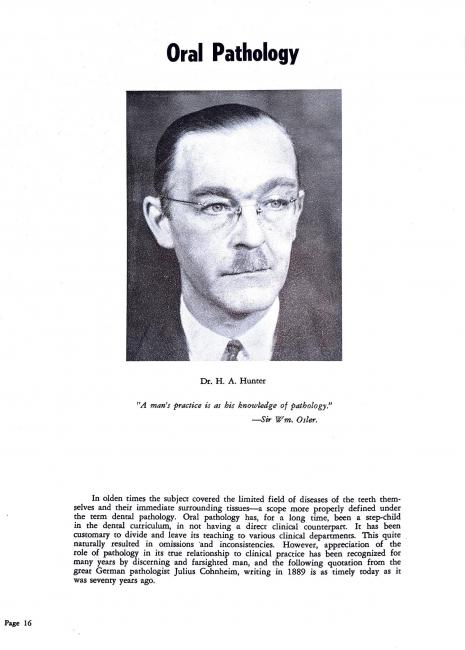Dr. H. A. Hunter
"A man's practice is as his knowledge of pathology."
-Sir Wm. Osler.
In olden times the subject covered the limited field of diseases of the teeth themselves and their immediate surrounding tissues—a scope more properly defined under the term dental pathology. Oral pathology has, for a long time, been a step-child in the dental curriculum, in not having a direct clinical counterpart. It has been customary to divide and leave its teaching to various clinical departments. This quite naturally resulted in omissions and inconsistencies. However, appreciation of the role of pathology in its true relationship to clinical practice has been recognized for many years by discerning and farsighted man, and the following quotation from the great German pathologist Julius Cohnheim, writing in 1889 is as timely today as it was seventy years ago.
Pathology is, on the one hand, as it treats of symptoms, an application of morbid physiology, and, on the other it shows how in the different diseases the various derangements of physiological function of the individual mechanisms are combined ... it is precisely the pursuit of morbid physiology which forms the best preparation for, and introduction to clinical study; you will thus be enabled to understand very much which would otherwise be simply retained by memory.”
For the past hundred years the emphasis in the practice of dentistry has been on the overwhelming backlog or restorative work. Much of this has involved problems of treatment planning more than diagnosis, but the undertaking of treatment presupposes a knowledge of the diseased state and the patient is entitled to expect this. It is an obligation of the practitioner to know the sequence of events in a disease if he is to discharge his professional duties properly. Without this background, practice becomes no more than empiricism.
The tide has turned, however, in the last few years from emphasis on the restorative aspects towards a programme of preventive treatment in an attempt to intercept Lental diseases, and, at the same time, broaden our interest and responsibility beyond the narrow confines of the dental tissues only. If we are to accept this wider field of responsibility, as the present trend would indicate, then we must have a knowledge of the aetiology and pathogenesis of the diseases to be found therein. This is tantamount to saying that we must have a working knowledge of pathology, because the two prime objectives of the science of pathology are just these two very points - the cause and progression of all diseases.
Pathology is a study that does not employ any disciplines peculiar to its own field, but utilizes those of the chemist, the anatomist, the bacteriologist, the physiologist, pharmacologist and geneticist. It is a blend of these basic sciences used to fulfill its above stated objectives.
The differences between a qualified dentist and a dental technician hinges largely on a knowledge of pathology for it determines the dentist's ability to make a diagnosis, state the prognosis and plan rational treatment. This is not to say that pathology has been ignored entirely. Interest in the diseases of the orofacial region goes back a long way, in fact, one of the first text-books on des pathology was John Hunter's “Natural History of Human Teeth," written in 1778. The quotation from William Osler, used in the title, is further emphasis pathology's importance. This, coming from one of greatest diagnosticians of all times, surely establishes rightful position in the teaching curriculum. The principles of general pathology have shared a place in undergraduate training programme for many years in faculty, but the recognition of oral pathology as an inte part of a comprehensive teaching schedule for student dentistry came into being a little more than ten years This has been a logical and inevitable step in the end transition from empiricism to rational treatment.
In the past, the time devoted to problems of diagnosis occupied a very small proportion of a dentist's chairside time, since he was wholely occupied with restorative tasks demanding his immediate attention.
What of the future? For the past hundred years dentistry's main effort to cope with clinical problems has been emphasized through the restorative approach. This has accomplished much, both in the volume of work done as well as the perfection of precise and intricate techniques. Nevertheless, these years have shown us that we are not gaining on the backlog of existing dental diseases. It is from a realization of this that we have recently turned our thoughts towards a concept of prevention as a more effective way to exercise control over disease. Surely, as soon as effective controls are put into action, the dentist's time will be spent, less on restoration, and more and more on problems of further preventive measures, public education and early interception of diseases. This will be the era of diagnosis, whose handmaiden is pathology.

